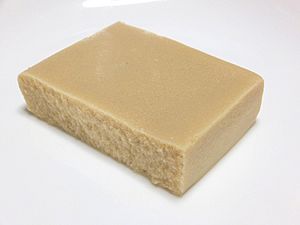Koya-dofu facts for kids
Koya-dofu (also called Shimi-dofu, Kori-dofu, or Koyasan-dofu) is a unique type of tofu from Japan. It's made by freezing and then drying regular tofu. This process turns it into a light, sponge-like food. Koya-dofu is a common item in Japanese kitchens and is very important in Buddhist vegetarian meals. It's made from soybeans, special ingredients that make it firm, and baking soda. Before you cook with it, Koya-dofu needs to be soaked in water because it's very hard when dry. People often use it in warm stews and soups.
Contents
The History of Koya-dofu
Freeze-dried tofu first appeared in Japan around the mid-1500s. It was created as a way to preserve tofu for a long time.
How Koya-dofu Started in Japan
In Japan, people learned to make freeze-dried tofu even before they made regular frozen tofu. There are two main places where Koya-dofu is believed to have started: Mount Koya and Nagano.
Mount Koya's Story
A Buddhist priest named Mokujiki Shonin helped develop Koya-dofu on Mount Koya in the early 1600s, during Japan's Edo Period. He wanted all the temples on the mountain to make their own tofu. This was to help them save food until the spring.
The process involved leaving firm tofu outside on cold, windy nights to freeze. Once frozen, it sat on shelves in a shed for about 15 days in freezing temperatures. Then, it was thawed in warm water and gently pressed to remove the melted ice. Finally, it was dried using heat from charcoal fires.
Nagano's Method
Nagano, located northeast of Tokyo, is another place where freeze-dried tofu began. It was first made here in the mid-1500s. A famous leader and warrior named Takeda Shingen developed a new drying method. His goal was to create nutritious, lightweight food for his soldiers.
In Nagano, firm tofu was frozen solid on boards outside in the snow. Then, it was wrapped in straw mats and kept in a cold barn for seven days. After that, five pieces of tofu were tied together with rice straw and hung from poles, away from direct sunlight. The tofu would thaw during the day and refreeze at night many times. This process turned the tofu into a hard, sponge-like food.
Koya-dofu in the West
One of the first times freeze-dried tofu was mentioned in Western writings was in 1880 by Paillieux. He wrote that frozen and dried tofu had a sponge-like texture, lasted a long time, and could be cooked in many ways. Later, in the early 1900s, Koya-dofu was mentioned in articles about Japanese foods and even as a preserved food used by the Japanese military.
How Koya-dofu is Made
Koya-dofu is made using a special method called freeze-drying. First, the water inside the tofu turns into ice. This freezing process changes the tofu's color, texture, size, and weight. After freezing, the tofu is thawed. At the end of this process, you get a beige, sponge-like piece of tofu.
How to Enjoy Koya-dofu
Before you can cook with Koya-dofu, you need to prepare it. Soak it in hot water for about five minutes. Then, gently press it to remove any extra water. Once prepared, Koya-dofu can be used in many ways. You can grind it into a fine powder or flour, or even make it into crispy tofu croutons. It's most commonly used in delicious stews and soups.


